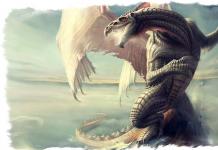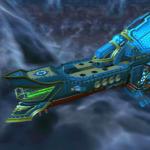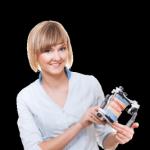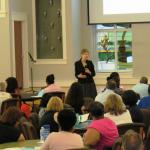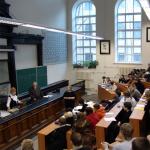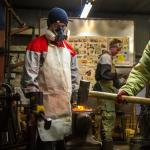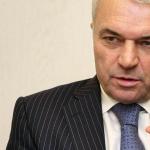Having a short experience of working in a correctional school, I came to conclusions about the need for careful preparation for reading lessons in high school.
Development of dialogic speech
The scientific and practical article will be of interest to teachers, educators and speech therapists working in correctional schools and boarding schools for children with disabilities (mental retardation)
Summary of the subgroup speech therapy lesson “Wild Animals”
This summary is aimed at practical mastery of grammatical categories on the topic “Wild Animals”
Abstract of the GCD “Neuropsychological approach to the formation of a group of prerequisites for mastering reading and writing in children preparatory to school”
This summary of direct educational activities has been developed for speech therapists and speech pathologists. It can also be used by teachers of speech therapy and correctional groups. Designed for children 5–6 years old in a speech therapy group. The material can be used by teachers to form the prerequisites for mastering reading and writing in children of senior preschool age, using a neuropsychological approach
Summary of joint educational activities with children of senior preschool age (5–6 years old) on speech development “Visiting a fairy tale”
This material will be useful to speech therapists and educators working with children of older preschool age (5–6 years old). Aimed at activating and enriching children's vocabulary based on Russian folk tales
The use of non-traditional working methods: elements of theatrical activities, sand therapy in the correction of general speech underdevelopment in preschool children
The methodological development is based on experience working with children with speech disorders. This methodological development for senior preschool age includes non-traditional methods for correcting speech disorders. Both speech therapists and special education teachers can use this in their work.
The methodological development can be used by educators and speech therapists in preschool educational organizations. It is designed to work with children 6-7 years old. The methodological development presents the creation of conditions for introducing the sound [l] into speech at the level of syllables and words through the organization of an individual speech therapy lesson using the interactive method of “storytelling” for children of senior preschool age on the topic “The History of the Lamp.”
Formation of a coherent utterance in preschool children with ODD using semantic fields
The article is addressed to speech therapists and educators working with children 5–7 years old with ODD. The proposed materials will help in expanding the vocabulary and developing coherent speech of preschoolers and primary schoolchildren. A developed and tested set of exercises and classes based on understanding the “semantic field” allows you to eliminate errors and difficulties in the selection of lexical means for constructing a coherent statement, provides conditions for clarifying the meaning of a word and the active use of learned concepts in speech
Target: Development of clear differentiation of sounds [s-sh] in syllables and words.
Tasks:
- Correctional and educational: improve reading techniques using the material of syllabic tables, activate vocabulary on the topics: “Shop”, “Vegetables and fruits”, “Toys”.
- Correctional and developmental: develop phonemic hearing and perception (sound-letter and syllabic analysis and synthesis of words), develop visual-spatial perception, articulatory motor skills, work on developing the level of concentration and distribution of attention, auditory attention and memory, analytical thinking.
- Correctional and educational: to develop skills of cooperation, a positive attitude towards participation in the lesson, and a responsible attitude towards completing tasks.
Equipment:
- magnetic letters,
- syllables,
- mirrors,
- typesetting canvas,
- syllable tables,
- stickers with images of vegetables and fruits,
- pictures of a counter,
- "price tags"
- cards - “money” - syllable patterns,
- toys,
- chips for performing sound analysis,
- stickers with images of animals.
Organizing time.
Game "Let's get to know each other."
We stand in a circle, holding on with our little fingers. The first player says his name, the second - the name of the previous one and his own, etc.
Development of sound-letter analysis and synthesis.
If you complete the task correctly, you will find out where we will go today.
Now I will compliment you and praise you. Your task is to highlight the third sound of each word and designate it with the corresponding letter:
- behind M Ready
- st A expedient
- before G adlivable
- etc A amazing
- ra Z twisted
- etc AND lying down
- By N fidgety
Children lay out the word “STORE” from the letters of the magnetic alphabet on the board.
Syllable analysis.
What should we take with us to the store?
You have cards under your tabletops. What is this? (Syllables).
Why do you think these are syllables? (Each part has a vowel).
Make words from these syllables:
- bag
- wallet
(A wallet is a small pocket bag for money.)
Why do we need these items?
Today, for your correct answers, I will give you this “money”. And why, you will find out a little later.
Characteristics of sounds “s-sh”. Articulation gymnastics.
Highlight the first sound in the word “bag”. Say it. In what position are the lips ("smile"), teeth (“fence”), language (“brushing our teeth”), air jet (cold narrow air stream along the “groove”) (The sound C is a consonant, because there is an obstruction, the sound is voiceless - the vocal cords do not work, it is hard.)
Highlight the third sound in the word “wallet.” Say it. In what position are the lips (“window”), teeth (“closer”), language ("cup"), air jet ( strong, warm, wide). Describe this sound. (The sound Ш is a consonant, because there is an obstruction, the sound is voiceless - the vocal cords do not work, it is always hard.)
What is the main difference between these sounds? (When pronouncing these sounds, the position of the tongue and lips is different.)
For correct answers: cards - “money”<Приложение 1 >.
Report the topic of the lesson.
Look closely at the typesetting canvas. Who can name the topic of the lesson?
Today we will not only go to the store, but we will also learn to distinguish the sounds “s-sh”.
Development of phonemic hearing.
And to do this, let’s work a little with the syllabic table<Приложение 2 >. I name the syllable, your task is to find this syllable in the table as quickly as possible and place your index finger on it.
Syllables: sho, sy, su, si, sha, so, shu, sa, shi.
Development of visual-spatial perception.
So, we go to the store. Name the products you see (pear, peach, beet, cabbage, parsley, potato, radish, plum) <Приложение 3 >. What store did we go to?
The seller did not have time to put the products on the shelves<Приложение 4 >. Shall we help her?
- place the pear on the top shelf on the left;
- to the right of the pear - potatoes;
- under potatoes - cabbage;
- place radishes on the second shelf on the right;
- above the radish - peach;
- between potatoes and peaches - plum;
- under the pear - beets;
- to the left of the radish is parsley.
Name what you put on the first shelf (pear, potato, plum, peach); to the second shelf (beets, cabbage, parsley, radishes).
The seller is very grateful to you, you helped her put the products on the shelves.
For correct answers: cards - “money”.
Development of analogical thinking.
Look closely at the first shelf. What's extra? (Potato.)
Why? (This is a vegetable, and everything else is fruit).
Look at the second shelf. What's extra? (Parsley.)
Why? (In the word “parsley” the sound is “sh”, and in all other words it is “s”).
For correct answers: cards - “money”.
Differentiation of letters "s-sh".
But in the store, each product is signed and the price is indicated on it. Let us help the seller sign the price tags<Приложение 5 >. But something is wrong here, what exactly? (The letters “s” and “sh” are missing).
Fill in the missing letters “s” or “sh” in the words.
Name the words in which you wrote the letter “s”, “sh”.
You completed the task. ( cards - “money”)
Development of syllabic analysis.
Let's go to the next store. What store were we in? (In a toy store).
You have money, but you can only buy that toy whose name matches the pattern on your card - “money”, i.e. The name of the toy should have the same number of syllables as in the diagram. Please note that the diagram shows which syllable contains the sound “s” or “sh”. You must clearly pronounce the word syllable by syllable and give the “money” to the seller.
Development of sound analysis.
Choose any toy from those you bought. Perform a sound analysis of this word.
Summary of the lesson.
What stores did we visit today? What other stores do you know?
What sounds did we name most often today? What is their main difference?
Reflection.
At the beginning of the lesson, I said that you are attentive, smart, diligent. I was not mistaken! Well done!
Choose a sticker that has the sound “sh” in its name as a reminder of today’s lesson.
Summary of a group speech therapy session on oral speech correction.
Topic: Paired voiced and voiceless consonants
Description: Mastering the correct designation of paired voiced and voiceless consonants in words is not an easy task. The effectiveness of its solution depends on many factors, including the development of students’ phonetic-graphic skills. These include: 1) the ability to correctly correlate sounds and letters; 2) the ability to consistently differentiate between paired voiced and voiceless consonants (during correction work, tactile and vibration control is carried out, pictograms are used); 3) the ability to determine the position (position) of a sound in a word and the quality of the sound (voicedness or dullness) in different positions. The material will be useful to speech therapists, primary school teachers, and parents.
Target: Consolidation of the program topic: “Voiced and voiceless consonants”;
Tasks:
Educational:
1. Develop the ability to analyze sounds according to plan;
2. Activate and enrich children’s vocabulary through answers to questions posed;
3. To form the skills of independent connected statements.
Corrective:
1. Promote the development of auditory attention and visual memory.
2. Development of phonemic hearing.
3. Voice development
4. Development of gross motor skills
Educational:
1. Formation of self-control over children’s speech.
2. Development of the ability to express one’s attitude to the activity and the environment.
3. Fostering respect for working people.
Progress of the lesson.
1. Organizational moment.Speech therapist: Hello, my dear children! Glad to meet you! I am pleased to see you all beautiful! Let's look at each other, smile at each other and begin our lesson.
I hope our joint work today will be successful and bring joy to all of us.
In order for our speech to be beautiful and correct, we must remember a very important rule:
Every day, always, everywhere, in class, in play,
That’s right, we say it clearly, we are never in a hurry.
We all repeat the rule out loud together. (slide 1)
2. Announcing the topic of the lesson. Goal setting.
Speech therapist: Look carefully at the table and guess what topic we will work on. Tell me, what do you know about this topic? (All student answers are listened to). (slide 2)Speech therapist: The topic of the lesson is “Paired voiced and voiceless consonants.” (slide 3)
Our lesson will be held in a festive and interesting way in the form of a fair.
Parsley (hand doll):
Dear gentlemen! Welcome everyone here!
People are gathering, the Fair is opening!
Petrushka has a cap on her head, I’m dressed smartly, let’s put on the caps too. (slide 4)
You have cards on your desk. We read them out loud. (We read the first three cards individually, we read the fourth card all together.)
1. Let's learn to distinguish and correctly pronounce voiced and voiceless consonants. (slide 5
2. We will speak correctly and beautifully. (slide 6)
3. We learn a lot of interesting things about the fair. (slide 7)
We will talk about this in class and make small discoveries.
4. Let's write a short poem about the fair. (slide 8)
3. Articulation gymnastics.
Once upon a time there lived a cheerful tongue in his house. Lips are the first doors to the house. Teeth are the second doors to the house. (slide 9)
We perform the exercise: “Smile and a fence”
And there is a ceiling in this house, it’s called the sky. (slide 10)
“Lift your tongue up, find the ceiling.”
We need language when we eat and talk. And the Little Voice helps us to make our words heard. He also lives in a house. This house is located in the throat. The little voice may or may not sleep. When the voice sleeps, it snores quietly, like this: “ssssss,” “sh-sh-sh-sh.” And when he wakes up, he sings songs. And he does it so loudly that everyone hears, like this: “z-z-z-z”, “z-z-z-z”! And the walls of Goloska’s house begin to tremble. We touch the neck with our palm. (slide 11)
4. Work with isolated sounds according to plan.
Speech therapist: Parsley, do you want to know what consonants there are?Consonant sounds are voiced and unvoiced. Voiced and voiceless consonants form pairs.
Assignment: let's try to pronounce sounds in pairs and determine why consonants are called pairs? The sound next to which we pronounce the empty square quietly, and next to which we pronounce the bell loudly and immediately name what exercise our speech organs are performing.
Each student has their own task card. Children read the cards aloud one at a time. We read the last column together with the speech therapist: when we pronounce consonants...
(slides 12, 13, 14, 15, 16, 17 are projected onto the screen in turn)
Speech therapist: Guys, you correctly remembered the voiced and voiceless consonants and determined their similarities and differences.
So, we made the first important discovery: “Pairs of voiced and voiceless consonants have a certain identical articulation. Their main difference from each other is the operation of the vocal apparatus.” (slide 18)
5. Communication of new material.
(Slide 19 is projected onto the screen)
Speech therapist: Previously, annual folk fairs were held in Rus'.
A big trade was held with fun and entertainment. (slide 20)
The fair was buzzing, noisy and represented a huge crowd of people trading and buying. No wonder they say: “The noise is like at a fair!” (slide 21) At fairs, puppet shows were held, the main character of which was the cheerful Petrushka. (slide 22, 23) The fair is always a real holiday, fun, laughter, joy. (slide 24)
Guys, what do you think the fair is? (Students' answers)
We made a second small discovery:
The fair is a holiday, fun, laughter, joy! (Read aloud together) (slide 25)
6. Development of phonemic hearing.
(slide 26)Speech therapist: What fun is there at a fair without music, don’t you agree Petrushka?! We will visit the market at the fair. Let each of you choose the musical instrument you like, and Petrushka will be the seller.
Parsley: Oh yes goods, oh yes beauty,
An unheard of miracle, an unprecedented marvel!
Children choose a musical instrument and sit down with it. Please name who chose what and determine whether the word has a paired consonant, is it voiced or voiceless? How to call an accordion, tambourine, rattle, pipe, drum, bell in one word?
Exercise 1: Pick up an instrument whose name begins with a voiceless consonant or a voiced consonant? You completed the task correctly.
Task 2: On your desks are cards with paired unvoiced and voiced consonants. Each has one consonant. You must find a pair for your consonant from other guys, go out together, correctly name a pair of consonant letters and determine which consonant is voiced and which is voiceless. Other guys will check whether you completed the task correctly. (slide 27)
7. Physical exercise.
Speech therapist: Let's organize a small performance with musical instruments.You and I will have fun and dance.
Cheerful music is playing.
We perform speech physical exercises with movement with the words:
Balalaika, Balalaika,
Let's strum, play!
Drum, drum!
Unfold the sides of the button accordion!
We raise pipes to the sky,
We blow loudly, loudly into the pipes.
We beat the tambourine, strum it, pipe it,
Let's drum and trumpet!
8. Differentiation of sounds in syllables, reading syllables according to the table.
(slide 28, 29)Speech therapist: Guys, what did our musical instruments sound like? (loud). Say the syllables in pairs, changing the strength and pitch of your voice. We will pronounce some syllables loudly, others more quietly; instead of the diagram, insert the desired missing syllable. Reading cards individually and in chorus.
9. Reporting additional new material
Speech therapist: Guys, are there any fairs now? (Children's answers) (slide 30)And now fairs are held in Russia. Craftsmen bring many handmade products to the fair; They also bring various other goods to the fair: honey, autumn harvest and much more. They are also noisy, festive, fun and interesting! Thanks to craftsmen, such holidays are created. (slides 31, 32, 33, 34, 35, 36, 37, 38, 39, 40, 41, 42) I'm sure there are those among you who love to draw, sculpt, embroider, and craft. Do you know how?
Listen to children's statements.
10. Creative task, reflection.
Speech therapist: All together we will compose a small poem on the topic: “FAIR” according to the diagram. (slide 43)FAIR
– noisy, cheerful, bright!
Cheers, makes noise, trades,
Brings joy to the house.
The fair glorifies people’s work!
We read the resulting poem aloud. (slide 44)
Parsley: So that there are no such unclear cases,
And there were no bad answers.
Listen to the sound of consonants,
So as not to confuse voiced and deaf!
Speech therapist: What did you learn today? What new things did you learn and what else would you like to know?
1. Today we learned to consolidate and correctly pronounce voiced and voiceless consonants. We found answers to all questions and made small discoveries.
I discovery: “Pairs of voiced and voiceless consonants have a certain identical articulation. Their main difference from each other is the operation of the vocal apparatus.”
II opening: “The fair is a holiday, fun, laughter, joy!” (slide 45)
2. Assessing children’s work for the lesson.
3. Assessment of children's activities.
You guys are in a good mood! I'm in a great mood too!
I want your fair to continue today in your classroom with friends over a cup of tea and bagels, and that you share your impressions of this fair with the people around you.
Thank you. Goodbye!
Presentation on the topic: Paired voiced and voiceless consonants
Lexical
- activation and enrichment of the vocabulary on the topic “Ground transport”;
- clarification and consolidation of knowledge about the main purposes of transport (passenger, cargo, special);
- repeating the meaning of traffic lights;
- updating of words denoting the components of a truck.
Grammar
- development of skills in constructing statements and reasoning;
- an exercise in the formation of plural nouns, strengthening the ability to coordinate a numeral with a noun.
2. Corrective and developmental:
- development of children's mental activity;
- development of fine and gross motor skills;
- development of ingenuity and intelligence in children;
- development of memory and attention;
- development of coordination of speech with movement;
- development of dialogical speech (ability to answer teacher’s questions).
3. Educational:
fostering independence and activity in the classroom.
Equipment:
- demonstration material - drawings depicting ground transport;
- circles made of colored cardboard: YELLOW, RED, GREEN;
- a cardboard truck for repeating “The Joke” using a poster;
- a poster depicting the components of a truck;
- markers.
Lexical material:
Ground transportation: passenger car, bus, trolleybus, tram, train, truck, excavator, fire truck, ambulance
Priority educational areas:"Cognition", "Communication"
Expected result (for a speech therapist teacher): Organize activities for students to consolidate knowledge about ground transport.
Expected result (for students): Consolidate knowledge about ground transport, improve the grammatical aspect of speech using the material of this topic.
Lesson time – 30 minutes
Progress of the lesson:
I. Organizational moment
Target: Activate substantive vocabulary on the topic “Transport”.
Speech therapist: Hello guys, today we have a very interesting lesson, and you will soon understand for yourself what it is dedicated to. Today you will not just be students, you will be car drivers! Take one upside-down card each and get into your cars (they sit at desks, with images of ground transport on the back of the chairs).
Speech therapist: Now, one by one, we will name who has what is shown in the picture. I will begin. I have a truck...(The children continue along the chain.) What is the name of all this, in one word?
Children: Cars, transport.
Speech therapist: That’s right, so you named the topic of the lesson yourself, it’s transport! This is exactly what we will talk about.
II. Main part
Conversation with children on the topic “Types of transport”
Purpose of the conversation: Review the main types of transport.
Speech therapist: In the last lesson I told you about types of transport. Which ones do you remember? I'll help: what kind of transport is it that moves underground? — underground; transport that moves on what water?, on the sky? — air, on the ground? – ground.
Children: Ground, air, water and underground.
Speech therapist: Well done, you tried to remember all types of transport, but today we will talk about one of them that surrounds us every day - ground transport.
Speech therapist: So, guys, the transport that moves on the ground is ground. Name the ground transport that you see every day on the streets of our village.
Children: Cars, trucks, buses, etc. What other ground transport do you know? Those who find it difficult to answer, look at your chairs, there are clues there!
Children: trolleybuses, trams, etc. (if there is difficulty, images are shown).
Speech therapist: Well done guys, you were attentive and accurate. So, we named: cars and trucks, buses, trams, trolleybuses.
Physical education lesson “Machine”
Target: Practice coordination of speech and movement.
Speech therapist: Let's stand at our seats and repeat after me.
Doesn’t fly, doesn’t buzz, (We push our hands forward twice, then put them on our belts.)
A beetle is running down the street. (We extend our arms to the sides twice, then place them on the belt.)
And they burn in the beetle’s eyes (We push our hands up twice and place them on our belts.)
Two shiny lights (Sit down.)
Speech therapist: Think and tell me, what is transport needed for?
Children: It transports people and goods.
Speech therapist: Well done, every day we see different vehicles on the streets that transport goods and people. But cars are created not only to drive or transport goods. There are cars that are designed to provide assistance in various situations. They are called special or service vehicles. Garbage trucks remove garbage, snow plows and sprinklers clean roads, ambulances help people who have had an accident or those who need medical help, etc. To help us remember some of these cars, I suggest you guess the transport that I encrypted for you. Two people will need to rearrange the letters on the board in reverse order, and the rest will check!
Special equipment:
YSCHOMOP YAROX Ambulance
ANISHAM JANRAJOP Fire truck
Traffic signals
Speech therapist: You cope well with tasks. And now we will repeat the traffic lights. Do you know what the red signal means? Children (...) And yellow, green? (Children answer).
Speech therapist: Right. The red light tells us: - Stop! Dangerous! The path is closed! Yellow: Wait for the signal to move. The green light is open for us.
Speech therapist: Guys, imagine yourself as drivers for a few minutes. Rotating an imaginary steering wheel with our hands, we will quickly rush along conditional paths, turning left and right. And you, as drivers, must react correctly to green, red, yellow signals. When I show the red circle, you “freeze” (you can call the presenter)
And at the end of our lesson, in order to better remember transport, I suggest you connect the drawn car and its outline (individual cards are offered on which it is proposed to connect drawings of transport and their silhouettes with lines)
III. Bottom line
Speech therapist: What did we talk about today?
Children: About ground transport.
Speech therapist: What other groups can transport be divided into according to purpose?
Children: For passenger, cargo and special.
Review knowledge about vowels and consonants and their designation in writing;
- develop the skill of spelling words with combinations “zhi”, “shi”;
- develop students’ spelling vigilance, thinking, imagination, oral and written speech;
- foster a sense of camaraderie and mutual assistance.
Visualization: envelopes with tasks (cut pictures, deformed text), plot pictures: Leopold the cat, mice.
Progress of the lesson:
1. Organizational moment.
Psychologist:
Hello guys!
Please look at our guests and say hello to them.
Sit down. Open your envelopes and collect the pictures, who did you get? (children collect cut-out pictures)
What cartoon characters are in front of you?
Let’s go with you to the magical land of knowledge, but in order to get there we need to do magic exercises and put on a magic cap. Ready?
Exercises:
Stretch each finger on one and the other hand;
- take a pencil and twirl it in your palms;
- now rub your palms together and warm your cheeks with them.
Exercise "Cap".
So, you and I found ourselves in a magical land of knowledge, whoever visits this country becomes the kindest, smartest, most attentive and learns to speak correctly. And who teaches us to speak and write lo-go-ped correctly...
Let's call our speech therapist!
2. Main part.
Look at the blackboard.
- What do you see? (Letters)
ZH A I SH U Y
What two groups can these letters be divided into? (vowels and consonants).
- What can be made from letters? (syllables).
- Write down the syllables with the letter Z on one line, and on the other with Ш.
ZHA ZH ZH ZH
SHA SHO SHI
Which vowel was the odd one out? (s)
- Why?
Who guessed what we will be working on today? (Words with the combination ZHI-SHI)
Yes. You and I are in an amazing land of knowledge where, let us remember how words with the combination ZHI and SHI are written.
In this amazing country
Everyone was literate
I've been there too
I learned a lot.
Oh guys, who is that crying? (Leopold the cat appears)
Leopold: What an unfortunate cat I am. These mice always play dirty tricks on me. And now they sent me from our cartoon to this country. And I can't get back. After all, the mice have set various traps with tasks, but I can’t complete the tasks, because cats don’t study at school. Help me guys!
Speech therapist: Guys, let's help the cat Leopold complete the tasks?
But in order to complete the tasks correctly, you need to remember the spell about the combination of ZHI-SHI.
Let's repeat together:
ZHI – SHI write with the vowel I.
So, task 1: “Feed the mice.”
Form words and write them down.
U CHI E KAMA WE
(hedgehogs, siskins, grass snakes, reeds, mice, ears).
What rule did we use to write words?
Well done! You have completed 1 task.
Now let's relax and play a game.
“One is many” (orally)
Already -......(snake)
Mouse –…..(mice)
Pencil - ……(pencils)
Playpen – …….(playpen)
Hedgehog – ……(hedgehogs)
Floor – …..(floors)
Swift - .....(swifts)
So, task 2 (riddles of Leopold the cat)
Leopold: The mice asked me riddles. Let's guys guess them together and write the answers in a notebook.
1. Will not travel without gasoline
Neither a bus nor... (car)
2. The cat lives on our roof,
And in the closet they live... (mice)
3. Every spring, spruce paws
Old lamps are replaced with new ones (bumps)
4. Mom knits a long scarf,
Because son... (giraffe)
5. Two snub-nosed girlfriends
They didn't leave each other behind.
Both are running through the snow,
Sing both songs! (skis)
Speech therapist: Well done, guys. We will complete one more task! It's time to rest.
 We decided to train the cat mice
We decided to train the cat mice
And they started giving sports assignments.
Get up on your toes
Squat down and stand up straight,
Hands to the sides, forward!
In the fist and on the side.
Stand on one leg,
It's like you're a steadfast soldier!
Now stay on the right.
It's like you're a brave soldier.
3 task.
Look, guys, Leopold the cat has prepared the next task for us. (on cards)
Compose and write down sentences. Emphasize the combinations “zhi” - “shi”.
The cat, Tishka, lived, Misha.
Vera, skis, y, new.
Fluffy snowflakes were spinning.
Well done boys! We completed another mouse task. Now let's play the game “Who is bigger?”
Come up with words based on the rule you learned. (children come up with words orally).
- Make up a sentence with the word...
And here is the last 4th task.
You guys need to continue the sentence: “If I met a wizard, I would wish...” (children make up their own sentences)
What would you wish for, you cat Leopold?
Leopold: I would like the guys to study at 4 and 5; so that everyone lives in harmony, and, of course, so that I immediately return to my cartoon home.
Speech therapist: Guys, Leopold the cat’s wish has come true. This means that you and I have completed all the tasks correctly.
3. Final part.
Psychologist: Guys, did you enjoy your trip through the land of knowledge?
Were there many interesting tasks?
What was the rule for these tasks?
I hope that there will be no errors in your notebooks regarding this rule!
Guys, for your help the cat Leopold left you gifts.
Minina Natalia Nikolaevna,
teacher speech therapist,
MBOU Secondary School No. 4, Salekhard


